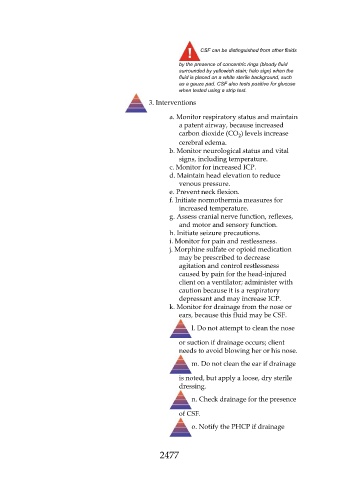Page 2477 - Saunders Comprehensive Review For NCLEX-RN
P. 2477
CSF can be distinguished from other fluids
by the presence of concentric rings (bloody fluid
surrounded by yellowish stain; halo sign) when the
fluid is placed on a white sterile background, such
as a gauze pad. CSF also tests positive for glucose
when tested using a strip test.
3. Interventions
a. Monitor respiratory status and maintain
a patent airway, because increased
carbon dioxide (CO ) levels increase
2
cerebral edema.
b. Monitor neurological status and vital
signs, including temperature.
c. Monitor for increased ICP.
d. Maintain head elevation to reduce
venous pressure.
e. Prevent neck flexion.
f. Initiate normothermia measures for
increased temperature.
g. Assess cranial nerve function, reflexes,
and motor and sensory function.
h. Initiate seizure precautions.
i. Monitor for pain and restlessness.
j. Morphine sulfate or opioid medication
may be prescribed to decrease
agitation and control restlessness
caused by pain for the head-injured
client on a ventilator; administer with
caution because it is a respiratory
depressant and may increase ICP.
k. Monitor for drainage from the nose or
ears, because this fluid may be CSF.
l. Do not attempt to clean the nose
or suction if drainage occurs; client
needs to avoid blowing her or his nose.
m. Do not clean the ear if drainage
is noted, but apply a loose, dry sterile
dressing.
n. Check drainage for the presence
of CSF.
o. Notify the PHCP if drainage
2477

